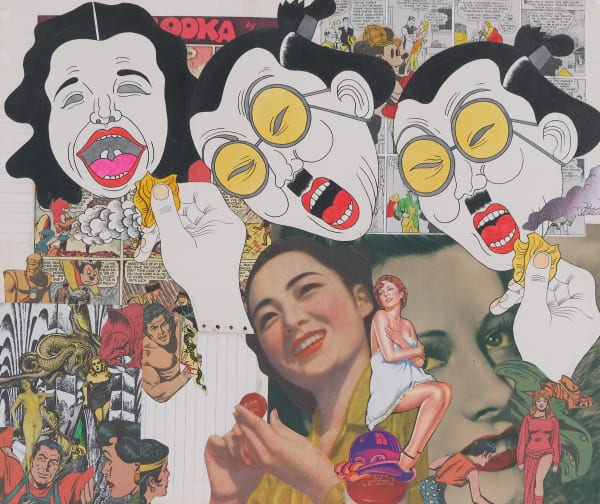Works
Biography
Keiichi Tanaami is one of the leading pop artists of postwar Japan, and has been active as a multi-genre artist since the 1960s.
He was 9 years old when Tokyo was bombed during the Great Tokyo Air Raid of World War II in 1945. Images seared into the back of his mind at this time would became major motifs in his art works: roaring American bombers, searchlights scanning the skies, firebombs dropped from planes, the city a sea of fire, fleeing masses, and his father’s deformed goldfish swimming in its tank, flashes from the bombs reflecting in the water.
Tanaami took to drawing from a young age, and as a junior high school student he often spent time at the studio of leading postwar cartoonist Kazushi Hara with the intention of becoming a cartoonist himself. After Hara’s sudden death, however, he turned to the pioneering field within manga of graphic novels, and went on to study at Musashino Art University. Word of his talent spread quickly during his time there and in 1958, and although after graduating he took a job with an advertising agency, he quit prematurely due to the numerous private commissions he was receiving. During the ‘60s he worked as a successful illustrator and graphic designer while also actively participating in the Neo-Dada organization, one of the defining art movements of postwar Japan. In the latter half of the ‘60s he also took up video art.
In 1967, Tanaami took his first trip to New York, where he was faced with the works of Andy Warhol, and was struck by the new possibilities they created within the art world.
“Warhol was in the process of shifting from commercial illustrator to artist, and I both witnessed and experienced firsthand his tactics, his method of incision into the art world. His strategies were identical to the strategies employed by advertising agencies. He used contemporary icons as motifs in his works and for his other activities put together media such as films, newspapers and rock bands. In other words, Warhol’s sole existence was selling his works to the art market. I was shocked by this, and at the same time I embraced him as the perfect role model for myself. Like Warhol, I decided not to limit myself to one medium, to fine art or design only, but instead to explore many different methods.”
At the height of psychedelic culture and pop art, Tanaami’s kitschy and colorful were praised both in and outside Japan. “NO MORE WAR”, his prize-winning piece from the 1968 antiwar poster contest organized by AVANT-GARDE Magazine, his album cover art for legendary bands The Monkees and Jefferson Airplane and other such works left a major footprint on the path to introducing psychedelic and pop art to Japan. Furthermore, his series of erotic paintings featuring Hollywood actresses done in the early ‘70s became an important body of work that declared Tanaami as the Japanese artist with a witty eye on American culture.
In 1975, Tanaami became the first art director of the Japanese edition of Playboy Magazine, “Monthly Playboy”.
Tanaami’s works from this period, mostly in the mediums of film and print, were provocative and experimental. His films in particular received wide critical acclaim, appearing in the International Short Film Festival Oberhausen in Germany (1975, 1976), the New York Film Festival (1976), and the Ottawa International Animation Festival in Canada (1976). The vanguard nature of his work led the police to shut down his 1976 exhibit “Super Orange of Love” at Nishimura Gallery for inspection on the opening day.
In 1981, at the age of 45, he suffered a pulmonary edema and for a time hovered at the edge of life and death. Throughout the ‘80s and ‘90s, Tanaami created many works centered around the theme of “Life and Death” based on the experience. For example, the pine tree form that appears frequently in Tanaami’s works comes from a hallucination he experienced during his illness. Similarly, the cranes, elephants and naked women that appear along with spirals and miniature garden-like architectural forms are characteristic of his works from this period.
Tanaami has worked as a professor at Kyoto University of Art and Design since 1991, where he has helped bring up young new artists such as Tabaimo. Recent exhibits include “Day Tripper” at Art & Public in Geneva (2007), “SPIRAL” at Galerie Gebr. Lehmann in Berlin (2008), “Kochuten” at NANZUKA UNDERGROUND (2009), “Still in Dream” at Frieze Art Fair (2010) and “No More War” at Art 42 Basel (2011).
Exhibitions
-

Paris Photo 2022
Grand Palais Éphémère • Stand D27 10 - 13 Nov 2022For this year’s edition of Paris Photo, the Michael Hoppen Gallery has curated an exhibition of exquisite, unique works. The term ‘unique’ has become ubiquitous, but we use it here...Read more -

THE ARMORY SHOW
BOOTH 416 2 - 5 Mar 2017An assortment of works from the collection that MHG will be taking to this years Armory art fair in New York.Read more
News
Enquire






